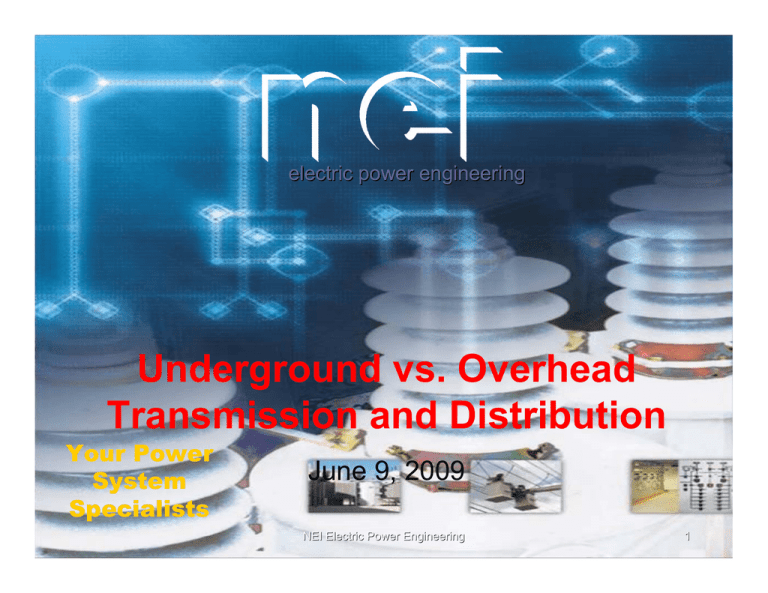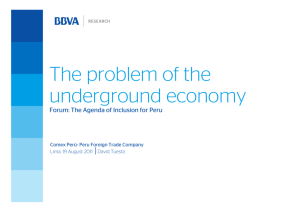Underground vs. Overhead Transmission and Distribution
advertisement

electric power engineering Underground vs. Overhead Transmission and Distribution Your Power System Specialists June 9, 2009 NEI Electric Power Engineering 1 NATIONAL TRENDS Municipalities have passed laws requiring new distribution facilities to be placed underground. For aesthetic reasons To increase property values (5-10% according to some studies) Cost covered by developers and ultimately paid by property owners. Provide better protection from storm damage and improve reliability of power supply. NEI Electric Power Engineering 2 Underground Construction and Storm Protection Underground construction CAN improve the reliability of the electric power system by minimizing damage to the system from: High winds Ice and snow storms Falling trees If part of the system is impervious to storm caused damage faster restoration of the system is possible. NEI Electric Power Engineering 3 Underground Construction is NOT Immune from All Storm Damage Flooding Hurricane Damage Earthquake Damage Lightning Damage Rodent and Human Damage (dig up) NEI Electric Power Engineering 4 Power System Components Transmission System 69,000 Volts and Above Less than 2% of all outages are due to transmission system outages. Subtransmission System 35,000 Volts Sometimes 69,000 Volts NEI Electric Power Engineering 5 Power System Components Distribution System 25,000 Volts and below Most outages occur here NEI Electric Power Engineering 6 Physical Limitations of Underground Lines The main argument against constructing underground systems is usually financial. But costs are not the only limitation. The laws of physics limit how physically long a power line can be. These limits are relatively unimportant on overhead lines but will severely limit high voltage underground cable systems. The higher the voltage the shorter the line length must be. The limiting effects become very important at transmission voltages, especially 100,000 Volts and above. Limiting effects may also be important for subtransmission voltages, 69,000 Volts and 35,000 Volts. NEI Electric Power Engineering 7 Physical Limitations of Underground Transmission Lines What is the limit? And Why? NEI Electric Power Engineering 8 Physical Limitations: The Effect of Capacitance Capacitance causes current to flow even when no load is connected to the cable. This is called “line charging current”. Underground line capacitance for power cables is far higher than overhead line capacitance. Wires are closer to each other Wires are closer to the earth (within a few inches). Underground lines have 20-75 times the line charging current that an overhead line has (depending on line voltage). If a line is long enough the charging current could be equal to the total amount of current the line can carry. This will severely limit its ability to deliver power. NEI Electric Power Engineering 9 Widespread Underground Transmission Systems are Not Practical A typical 345,000V transmission line will be able to deliver no power when the line becomes about 26 miles long. The longest underground circuits at 230,000 or 345,000V are 20 miles long. Replacing overhead with underground lines will also change other characteristics of the line and connected power system. Resistance will go down (probably beneficial) Inductance (resistance to the flow of AC current) will also go down. Voltage regulation will become much more difficult. Line losses may increase and efficiency might become worse. Time to repair the line will be much longer, an unacceptable condition for a transmission line since outage times are limited. NEI Electric Power Engineering 10 Other Transmission Issues Widespread changes to underground cable in New Hampshire would cause power flow, voltage regulation, system stability, and other unforeseen changes over the whole NE grid. System studies will be needed to determine the effect of line characteristic changes. NERC requirements could produce hidden costs. Presently available switching devices (circuit breakers) may not be capable of switching long underground lines. Massive re-engineering of the entire NE power grid may be needed. Underground transmission line construction may be 20 times the cost of overhead construction. (A $3 million/mile line becomes $60 million/mile.) NEI Electric Power Engineering 11 Other Issues Currently underground AC transmission is primarily used only where nothing else will do. River Crossings In dense urban areas Large road crossings Where aesthetic issues are paramount (national parks) Aspen, Colorado: Special tariffs were imposed on customers. A move to install underground transmission cables may require a conversion from AC to DC transmission. Long underground DC Transmission systems are possible. DC Transmission does not suffer from the same problems as AC. DC Transmission has its own additional costs, primarily converter stations. Studies would still be needed to determine the effects on the NE power grid of a widespread conversion to DC transmission. NEI Electric Power Engineering 12 How about 35kV Subtransmission? Underground 35kV is becoming common. Wind farms Some cities have installed 35kV underground distribution. HOWEVER: Problems are occurring. Ferroresonance problems Early switchgear and cable failures. Time to repair underground lines exceeds overhead lines and may offset any reliability advantage. Charging current switching limitations of available breakers/reclosers limit line length to less than 15 miles. NEI Electric Power Engineering 13 Distribution: 15kV and Below 80% of all outages occur on the distribution system. 15kV underground distribution is becoming very common for new lines. The number of outages due to underground distribution are far less than overhead distribution. An improvement of up to 10 times is possible when lines are placed underground. HOWEVER: Time to repair, outage duration, is much longer (up to 10 times longer) for radial distribution systems (the most common type). The two effects counterbalance each other and underground radial lines may be no more reliable than overhead lines. They will be impervious to widespread outages due to ice. Underground systems are harder to modify. NEI Electric Power Engineering 14 The Main Objection to Underground Distribution Lines Can Be Solved The distribution system can be changed from radial to looped. This greatly reduces outage time. Radial Distribution System NEI Electric Power Engineering 15 Looped Distribution System Using a looped distribution system can minimize outage duration time and still keep the advantage of infrequent outages inherent in underground construction. Installing spare conduit can also facilitate repair. Reliability indices SAIDI, SAIFI, CAIDI will nearly always improve when switching to this type of system. One type of looped distribution system. NEI Electric Power Engineering 16 Underground Distribution System Costs Underground distribution system costs vary greatly depending on conditions. Easements and indemnifications must be obtained from owners. Soil conditions can greatly affect costs. At times placing lines underground may simply not make sense. Overhead lines may have considerable life left. Repairing, patching, and restoration costs can vary greatly. A price of $3,500/customer is cited in many studies, and has been shown in practice, to be the average cost for converting to underground construction in a municipal distribution system where certain conditions apply. If it is done as a long term (many decade) project. If it is done in coordination with other projects like road repair. If it is done in conjunction with retiring old overhead lines. If the municipality passes ordinances making underground lines required for new construction and new costs are passed to homeowners. NEI Electric Power Engineering 17 Underground Distribution System Costs A price of $3,500 per customer would double the rate charged for electricity. Estimates from varying sources say rates would increase 110150%. Rates may not return to near previous levels until the original investment is paid off (25-40 years). This estimate applies only to cases where underground conversion presents no unusual problems: municipal distribution systems which can be easily looped and where no unusual conditions apply. This estimate does not apply to placing 100% of the State’s distribution system underground. The four utilities serving New Hampshire have provided information which indicates that the cost of a project to place 100% of the State’s distribution system underground would be in excess of $40,000.00 per customer. NEI Electric Power Engineering 18 Summary of Costs: Overhead vs. Underground Transmission: Underground may be 4-20 times Overhead. Subtransmission: Underground may be 4-20 times Overhead. Distribution: Underground may be 2-10 times Overhead. New underground may be cheaper than overhead in special conditions and costs vary greatly from utility to utility and place to place. NEI Electric Power Engineering 19 Conclusion It will cost more to place lines underground than overhead. Underground lines are protected from some, but not all, types of storm damage. Replacing all the overhead lines in a state (transmission and distribution) with underground lines is probably not possible or desirable. It is highly impractical (and probably impossible) to place all AC transmission lines underground. Selective short underground installations are possible. 35kV subtransmission systems may be placed underground if less than approximately 15 miles, however other problems may occur. It may be beneficial to place 15kV distribution systems underground if the installation costs are acceptable and if the system can be configured as a looped system. NEI Electric Power Engineering 20 Q&A Keith Malmedal Ph.D. P.E, P.Eng. NEI Electric Power Engineering P.O. Box 1265 Arvada, CO 80001 303-431-7895 kmalmedal@neiengineering.com NEI Electric Power Engineering 21






